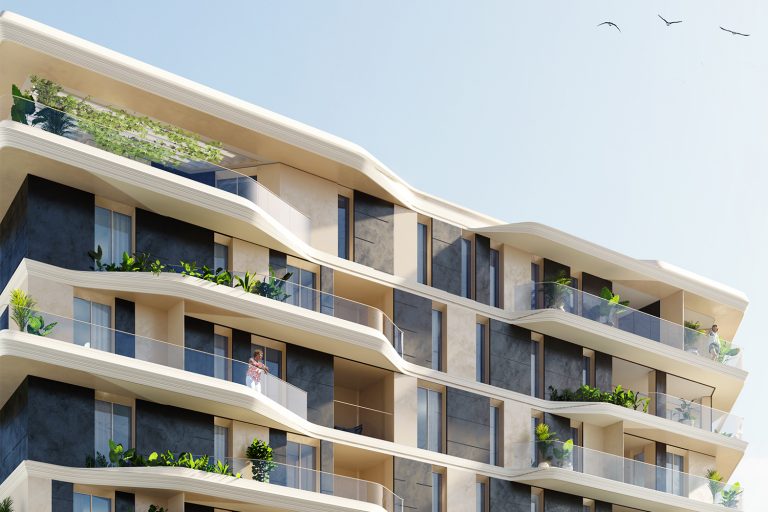
The Millefeuille Pavilion is a robotically fabricated temporary pavilion, installed at the University of British Columbia. The pavilion was made by students and industry professionals seeking to learn more about the roles of robots in timber fabrication. The pavilion is made as part of a workshop hosted by the School of Architecture and Landscape Architecture (SALA) and the Centre for Advanced Wood Processing (CAWP), which took place from June 4-8, 2022. The workshop was led by Associate Professor David Correa of the University of Waterloo, Oliver David Krieg of Intelligent City, and Associate Professor Anna Lisa Meyboom from UBC SALA.
The experimental structure demonstrates how traditional materials can collaborate with new designs and high-accuracy fabrication technologies to create high-performance structures, pushing the limits of how we build. The installation is part of a larger study into the potential of timber design using parametric design software, integrated data workflows, and robotic fabrication technologies. It is one of five full-scale pavilions constructed at UBC since 2015.

The free-standing structure is a multi-layered plywood assembly that is entirely supported by precise wood-to-wood joinery. Wood can be bent, cut, machined, or laminated into almost any shape. Wood, on the other hand, has traditionally been used in straight, hierarchically arranged sections. Rather than using straight, pre-cut sections, the pavilion investigates the limits of elastically bent plywood to create a free-form and lightweight, self-supporting structure. The general geometric principle is derived from the elastic bending limits of the wood member, in this case, plywood.
The design forces each component to bend to its maximum, and when the curvature demands a tighter radius than the wood can provide, a lamination pattern begins. The resulting design celebrates the formal potential of the curved plywood while increasing sectional depth through Mille-Feuille-like layering. Computational design tools and robotic timber fabrication tools are used to design the geometry of the pieces and their corresponding joints. The layered structure is made up of 150 different wood planks connected by 43 webs. All of the components are assembled in a specific order using only wood joinery; no screws or nails are used.



Starting with parametric design tools, structural principles for wood construction, robotic CNC milling, and digital workflow management, workshop participants were provided with a unique insight into the new opportunities and challenges of advanced design-to-fabrication processes for timber structures. Parametric design and robotic fabrication are disruptive new technologies in architecture that allow us to build high-performance structures of unprecedented formal complexity.
Wood is a natural partner for these technologies because of the ability to easily mill and shape it with robotically controlled cutting tools. Wood is also highly sustainable – not only is it a renewable resource but it also stores carbon – making it one of the most sustainable building materials in the world. This experimental structure demonstrates the new capabilities of the technology to develop innovative material applications that harness the unique properties of wood to animate public spaces.
Fabricated and assembled over three days, the Millefeuille Pavilion is conceived as an adaptable design-to-fabrication system that can be customized to suit local material availability and fabrication tools. The output geometry also included enough detail to give instructions on the placement of every subsequent piece, thus allowing the assembly to proceed very quickly. Built using the state-of-the-art eight-axis industrial robot at CAWP, the pavilion demonstrates how old materials and new technologies can reshape our built environment.


Project Info
Design & Development
University of Waterloo: David Correa
Intelligent City: Oliver David Krieg
UBC SALA: AnnaLisa Meyboom
UBC Centre for Advanced Wood Processing: Jason Chiu, Brandon Chan, Claudia Ediger, Lief Eriksen
Student Participants: Kenneth Anggara, Nora Boone, Meena Chowdhury, Adrian Chiu, Sarah Garland, Marina Ibrahim, David Kalman, Nicholas Krahn, Sahar Kazemeini, Yuxiang Liu, Isabelle Luisser, Aïden Mézidor, Lorena Polovina, Sarah Pitoscia, Changwei Qiu, Esraa Saad, Tyler Solu, Piero Sovrani, Jay Starnino, Carissa Tzeng
Teaching Assistants: Julieta Alva, Maverick Chan, Angela Gmeinweser, Parastoo Varshosaz
Support: UBC School of Architecture & Landscape Architecture, UBC Faculty of Forestry, UBC Campus & Community Planning
Funding: Forest Industry Innovation
Film Production: Shabaan Khokhar
Industry Participants:
Marc-Antoine Chartier-Primeau – 3XN Architects /GXN Innovation Jesse Cotey
Kurt Drachenberg – Fast + Epp structural engineering
Dave Dunn – BCIT
Tobias Fast – Fast + Epp structural engineering
Eytan Fiszman – Fast + Epp structural engineering
Michael Frazier – Christine Lintott Architects Inc.
Ben Hayward
Greg Hoffart – Tree Construction Inc.
Alan Hung
Ainsley Jackson
Breena Jackson – BCIT
Danny Jacobsen – Fast + Epp structural engineering
Katherine Kovalcik – MGA | Michael Green Architecture
Nazlee Markowsky – studioHuB architects
Sebastien Sarrazin – Perkins & Will
Esaly Wu
Billy Ying Wai Ma
Dazhong Yi – IBI Group























































